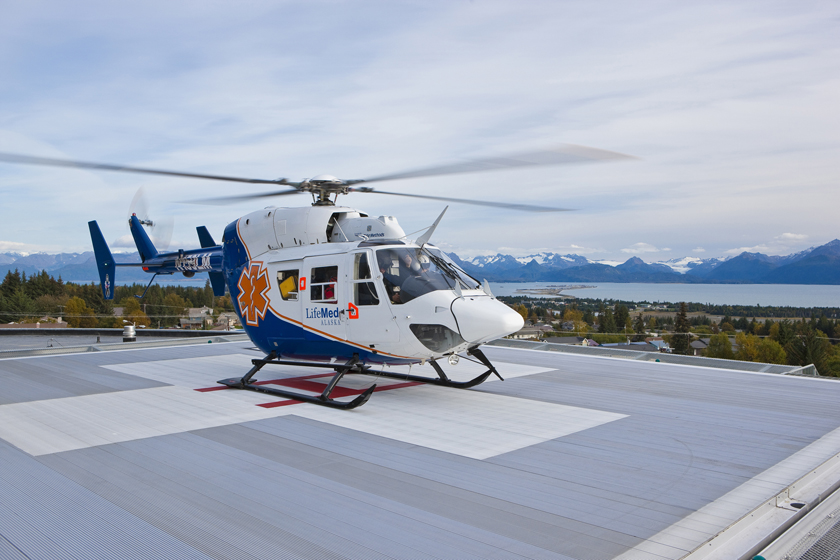An omission in Homer’s city code has prompted a proposed revision of where heliports can and cannot be allowed.
While most helicopters land and take off at the Homer Airport, another frequent landing spot is the pad on the roof of South Peninsula Hospital when medevac flights deliver or transfer patients.
According to a city press release, the district that includes the hospital is zoned as residential office, a classification that does not include heliports or other helicopter uses. A proposed ordinance seeks to change that by adding “helipad” as an accessory use incidental to a hospital conditional use.
At 6:30 p.m. Wednesday at City Hall in the Cowles Council Chambers, the Homer Advisory Planning Commission holds a public hearing on a draft heliport/helipad ordinance that would add as a conditional or accessory use helipads to some areas and remove heliports from other areas. Oral comments will be taken at the meeting or can be delivered to the Planning and Zoning Office or emailed to planning@ci.homer.ak.us.
City Planner Rick Abboud said no one has complained about medevac flights from the hospital.
“Nobody’s making an issue of the hospital at all,” he said. “We’re trying to fix the code so it makes sense.”
City code defines heliports as any place where helicopters regularly land and take off, and where they can be serviced or stored. The draft ordinance adds helipads as a use, meaning “any surface where a helicopter takes off or lands, but excludes permanent facilities for loading or unloading goods or passengers, or for fueling, servicing or storing helicopters.” Abboud said a helipad would be the category of use to cover South Peninsula Hospital’s landing pad.
One of the major air ambulances serving Homer is LifeMed Alaska. LifeMed stages AStar AS350 helicopters out of Palmer and Soldotna. In Soldotna, LifeMed helicopters are at Central Peninsula Hospital, with crews on stand-by 24 hours.
The AS350 holds one patient in a stretcher, a pilot, a critical-care paramedic and a flight nurse. It’s about a 20-minute helicopter flight from Soldotna to South Peninsula Hospital, said Scott Williamson, director of flight operations for LifeMed. The trip from Homer to Anchorage is about a 50-minute flight.
LifeMed did 23 helicopter medevac flights to South Peninsula Hospital last year and 30 so far for 2014, said hospital spokesperson Derotha Ferraro. LifeMed and other services also can fly fixed-wing aircraft to the Homer Airport.
LifeMed helicopters can be fueled from a truck at the Central Peninsula Hospital base, but are usually fueled at Anchorage. When helicopters come to South Peninsula Hospital, typically the pilot drops off the paramedic and flight nurse, and while they are preparing the patient, goes to the Homer Airport to refuel. By the time the helicopter is refueled and returns to the hospital, the patient is ready for transfer. LifeMed helicopters also can land at remote sites, such as highway car crash scenes.
“We’ve landed before in people’s backyards,” Williamson said. “That helicopter is a little intensive-care unit.”
In July, South Peninsula Hospital also installed on its helipad a fire pump and valve that connects to a foam fire-suppression nozzle, said Ferraro.
Like a lawn sprinkler, the nozzle automatically oscillates when turned on. It’s manually activated but operated remotely. The new equipment makes the hospital’s helipad 100-percent compliant with fire suppression requirements, she said.
The draft ordinance would eliminate heliports as a conditional use from the Rural Residential, Urban Residential, Central Business District, General Commercial 1, Marine Commercial and Open Space-Recreational zoning districts. It leaves heliports as a conditional use in the Marine Industrial zoning district.
“It was widespread,” Abboud said of the heliport conditional use designation. “Most of our districts had options for heliports. That raised a few eyebrows — oh, a heliport could come next door.”
The draft ordinance also adds helipads as a conditional use to the Residential Office zoning district that includes the hospital as well as the General Commercial 2, Marine Industrial and Bridge Creek Watershed Protection district. Helicopter use at the Homer Airport would remain unchanged.
“What we’re saying with this whole thing is, frequent helicopter operations are best left at the airport,” Abboud said. “We think the airport is the perfect place for that.”
Abboud said emergency landings by helicopters would still be allowed.
“It doesn’t mean a helicopter couldn’t land in an emergency situation anywhere they want to,” he said of the draft ordinance. “This would be for frequent flights.”
Williamson of LifeMed said inside the more populated areas of Homer, ground ambulances usually will respond to emergencies and deliver patients to South Peninsula Hospital if a helicopter medevac is needed.
Michael Armstrong can be reached at michael.armstrong@homernews.com.


